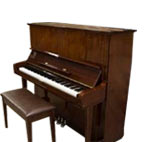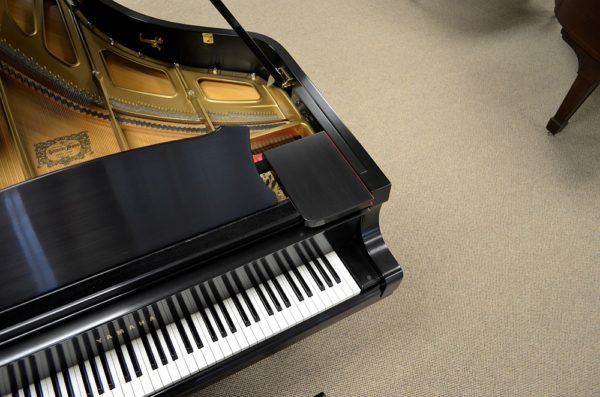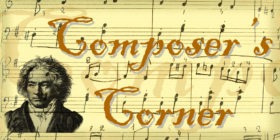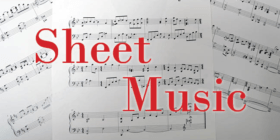|
|
Maritime Music: Songs of the Water
 Listen now! In honor of the Museum’s “On the Water” exhibition, this edition of Sounds of America presents a program of music from the Smithsonian Folkways collection inspired by waterways in the United States and around the world.The sea and other water ways such as large lakes, long rivers, and wide bays, have inspired songs for centuries. Maritime music plays a major role in life on the water, through its ability to entertain, motivate, and pace seamen in their work. Sailors and fishermen sing rhythmic songs called chanteys while pulling in nets, hauling anchors, and setting sails in unison. Songs are composed to commemorate battles at sea, pirate attacks, or storms. Some maritime songs celebrate particular bodies of water dear to a singer/songwriter’s heart; others remind seafarers who and what waits for them on land.For more information on songs in this program, visit Smithsonian Global Sound. Additional maritime music can be found on the “On the Water” Web site.Image: Cover from Classic Maritime Music, one of the albums in the Smithsonian collection featured in this month’s program. Listen now! In honor of the Museum’s “On the Water” exhibition, this edition of Sounds of America presents a program of music from the Smithsonian Folkways collection inspired by waterways in the United States and around the world.The sea and other water ways such as large lakes, long rivers, and wide bays, have inspired songs for centuries. Maritime music plays a major role in life on the water, through its ability to entertain, motivate, and pace seamen in their work. Sailors and fishermen sing rhythmic songs called chanteys while pulling in nets, hauling anchors, and setting sails in unison. Songs are composed to commemorate battles at sea, pirate attacks, or storms. Some maritime songs celebrate particular bodies of water dear to a singer/songwriter’s heart; others remind seafarers who and what waits for them on land.For more information on songs in this program, visit Smithsonian Global Sound. Additional maritime music can be found on the “On the Water” Web site.Image: Cover from Classic Maritime Music, one of the albums in the Smithsonian collection featured in this month’s program. |
 |
 |
|
|
Songs of the Civil War
 Listen now! The year 2009 marked the 200th anniversary of Abraham Lincoln’s birth. As part of the Smithsonian Institution’s yearlong celebration, we present a program of music about the 16th president and the American Civil War.During the Folk Revival of the 1950s and 1960s, Folkways Records (now Smithsonian Folkways) founder Moses Asch released many new recordings of historical songs, includingThe Glory of Negro History, narrated by poet Langston Hughes, and Songs of the Civil War,produced by Sing Out! co-founder Irwin Silber. Both albums present versions of the “Battle Hymn of the Republic,” perhaps the best-known Civil War song. It was written in 1861 by Julia Ward Howe to the same tune as “John Brown’s Body,” another song from the era performed here by political singer Joe Glazer.Also included are legendary bluesman Lead Belly’s tribute to Lincoln, excerpts from the autobiography of Frederick Douglass (read by Ossie Davis), and Pete Seeger’s version of Lincoln’s campaign song “Lincoln and Liberty.”Image: Cover from Ballads of the Civil War, one of the albums in the Smithsonian collection featured in this month’s program. Listen now! The year 2009 marked the 200th anniversary of Abraham Lincoln’s birth. As part of the Smithsonian Institution’s yearlong celebration, we present a program of music about the 16th president and the American Civil War.During the Folk Revival of the 1950s and 1960s, Folkways Records (now Smithsonian Folkways) founder Moses Asch released many new recordings of historical songs, includingThe Glory of Negro History, narrated by poet Langston Hughes, and Songs of the Civil War,produced by Sing Out! co-founder Irwin Silber. Both albums present versions of the “Battle Hymn of the Republic,” perhaps the best-known Civil War song. It was written in 1861 by Julia Ward Howe to the same tune as “John Brown’s Body,” another song from the era performed here by political singer Joe Glazer.Also included are legendary bluesman Lead Belly’s tribute to Lincoln, excerpts from the autobiography of Frederick Douglass (read by Ossie Davis), and Pete Seeger’s version of Lincoln’s campaign song “Lincoln and Liberty.”Image: Cover from Ballads of the Civil War, one of the albums in the Smithsonian collection featured in this month’s program. |
 |
 |
|
|
“Do You Know Your Country?”: Songs of American Places
 Listen now! On November 21, 2008, the National Museum of American History reopened its doors after a two-year renovation period. The Museum contains approximately 3 million artifacts representing all fifty states and Puerto Rico. In celebration of the reopening, this edition of Sounds of America includes songs specific to several regions of the United States.The Smithsonian Folkways collection of more than 3,000 albums features songs from nearly every American region and musical style. Many of those songs are linked to geographic places either literally, as in Cephas & Wiggins’ localized arrangement of a traditional blues (“Richmond Blues”); in theme, as in Woody Guthrie’s call for farmers and laborers across the continent to organize (“Farmer-Labor Train”); or both, as in Nani Wolfgramm and the Islanders’ ode to their home state (“There’s No Place Like Hawaii”).While this patchwork of place-songs ranges from popular standards to old-time fiddle, acoustic blues to cowboy ballads, New Mexico corridos to New York calypso, it collectively communicates more than just the stories from a particular locale; it also paints an aural picture of the people, cultures, and social climates of those places at various times in our history. So listen and enjoy these songs about New York, Alabama, Ohio, Kansas, Missouri, Alaska, Hawaii, Puerto Rico, and many others in between.Image: Cover from 20 Golden Hits of Hawaii, one of the albums in the Smithsonian collection featured in this month’s program. Listen now! On November 21, 2008, the National Museum of American History reopened its doors after a two-year renovation period. The Museum contains approximately 3 million artifacts representing all fifty states and Puerto Rico. In celebration of the reopening, this edition of Sounds of America includes songs specific to several regions of the United States.The Smithsonian Folkways collection of more than 3,000 albums features songs from nearly every American region and musical style. Many of those songs are linked to geographic places either literally, as in Cephas & Wiggins’ localized arrangement of a traditional blues (“Richmond Blues”); in theme, as in Woody Guthrie’s call for farmers and laborers across the continent to organize (“Farmer-Labor Train”); or both, as in Nani Wolfgramm and the Islanders’ ode to their home state (“There’s No Place Like Hawaii”).While this patchwork of place-songs ranges from popular standards to old-time fiddle, acoustic blues to cowboy ballads, New Mexico corridos to New York calypso, it collectively communicates more than just the stories from a particular locale; it also paints an aural picture of the people, cultures, and social climates of those places at various times in our history. So listen and enjoy these songs about New York, Alabama, Ohio, Kansas, Missouri, Alaska, Hawaii, Puerto Rico, and many others in between.Image: Cover from 20 Golden Hits of Hawaii, one of the albums in the Smithsonian collection featured in this month’s program. |
 |
 |
|
|
“Música Latina”: Latino Music in the U.S.
 Listen now! Over 42 million Latinos make the United States their home. One out of eight Americans uses labels like Latino, Hispanic, Tejano, Chicano, Mexicano, New Yorican, Cuban,Nuevomexicano, salvadoreño, and colombianoto point to their Spanish-speaking heritage in Latin America or the United States. Hand-in-hand with the burgeoning Latino population has come an equal infusion of Latino music, usually called música latina in the windows and bins of record stores.Since 2001, Smithsonian Folkways Recordings and the Center for Folklife and Cultural Heritage have collaborated with the Smithsonian Latino Center to highlight grassroots Latino musicians and music in a variety of ways, including programs, exhibitions, and 19 new recordings. This month’s program draws from the Latino audio holdings of the Folkways Collections—old and new—creating a cultural pastiche of sounds, styles, and cultures that hint at the vast cornucopia of music and cultural expression in the Latino world.Image: Cover from Taquachito Nights: Conjunto Music from South Texas, one of the Smithsonian Folkways albums featured in this month’s program. Cover art by Joe Lopez. Listen now! Over 42 million Latinos make the United States their home. One out of eight Americans uses labels like Latino, Hispanic, Tejano, Chicano, Mexicano, New Yorican, Cuban,Nuevomexicano, salvadoreño, and colombianoto point to their Spanish-speaking heritage in Latin America or the United States. Hand-in-hand with the burgeoning Latino population has come an equal infusion of Latino music, usually called música latina in the windows and bins of record stores.Since 2001, Smithsonian Folkways Recordings and the Center for Folklife and Cultural Heritage have collaborated with the Smithsonian Latino Center to highlight grassroots Latino musicians and music in a variety of ways, including programs, exhibitions, and 19 new recordings. This month’s program draws from the Latino audio holdings of the Folkways Collections—old and new—creating a cultural pastiche of sounds, styles, and cultures that hint at the vast cornucopia of music and cultural expression in the Latino world.Image: Cover from Taquachito Nights: Conjunto Music from South Texas, one of the Smithsonian Folkways albums featured in this month’s program. Cover art by Joe Lopez. |
 |
 |
|
|
“White House Blues”: Music of American Politics
 Listen now! The American political process has been intertwined with music as long as there has been a United States of America. From “Follow Washington,” one of many songs written in praise of George Washington, to the popular theme songs used by present-day candidates, every election cycle has had its accompanying soundtrack.Before technology made it possible for candidates to spread messages across the nation through mass media, campaign songs— often set to popular melodies of the time—were used to reach broad populations, especially those that could not read newspapers. One memorable example is “Tippecanoe and Tyler Too,” set to the melody of the song “Little Pigs” and written to praise 1840 presidential candidate William Henry Harrison. Known as the “hero of Tippecanoe” after a battle at the Tippecanoe River in Indiana, Harrison and running mate John Tyler went on to win the election, though Harrison died of pneumonia one month after his inauguration.Natural accompaniments to political campaign songs are political satire and protest songs, and both categories are represented here by folk singer Joe Glazer and civil rights leader Hollis Watkins. Glazer, Oscar Brand, and Peter Janovsky each recorded albums of presidential campaign songs that, along with the other songs presented here, are part of the catalog of Smithsonian Folkways.Image: Cast-iron figures of a donkey with a portrait of William Jennings Bryan and an elephant with the likeness of William H. Taft, created for the election of 1908. From the collections of the National Museum of American History. Listen now! The American political process has been intertwined with music as long as there has been a United States of America. From “Follow Washington,” one of many songs written in praise of George Washington, to the popular theme songs used by present-day candidates, every election cycle has had its accompanying soundtrack.Before technology made it possible for candidates to spread messages across the nation through mass media, campaign songs— often set to popular melodies of the time—were used to reach broad populations, especially those that could not read newspapers. One memorable example is “Tippecanoe and Tyler Too,” set to the melody of the song “Little Pigs” and written to praise 1840 presidential candidate William Henry Harrison. Known as the “hero of Tippecanoe” after a battle at the Tippecanoe River in Indiana, Harrison and running mate John Tyler went on to win the election, though Harrison died of pneumonia one month after his inauguration.Natural accompaniments to political campaign songs are political satire and protest songs, and both categories are represented here by folk singer Joe Glazer and civil rights leader Hollis Watkins. Glazer, Oscar Brand, and Peter Janovsky each recorded albums of presidential campaign songs that, along with the other songs presented here, are part of the catalog of Smithsonian Folkways.Image: Cast-iron figures of a donkey with a portrait of William Jennings Bryan and an elephant with the likeness of William H. Taft, created for the election of 1908. From the collections of the National Museum of American History. |
 |
 |
|
|
“Don’t Fence Me In”: Music of Texas
 Listen now! You can’t typecast Texas music; there’s just no “reining it in.” From the sounds of Texas blues, swing, and conjunto, to country and western, gospel, and Tejano music, the state’s musical range constantly reminds us of the lively cultural landscape of the Lone Star State.The influence of Texas musical traditions on quintessentially American genres such as blues, jazz, rock and roll, and country and western is undeniable. And the significant contributions of the state’s Hispanic population, such as the various folk and popular forms of Tejano music, inform the growing popularity of Latin-flavored and Spanish-language music in the twenty-first century.The diversity of Texas musical styles resulted from a cross-pollination of sounds—what makes American music great. By borrowing tunes, passing on licks, and adopting new rhythms, Texas artists continue to create new traditions. Listen to these Texas tunes from the Smithsonian Folkways collections.Image: Narciso Martinez (right), considered the founder of the contemporary conjunto style, made the genre’s first truly popular recording with “La Chichoronera” in 1935. Photo by Al Rendon. Listen now! You can’t typecast Texas music; there’s just no “reining it in.” From the sounds of Texas blues, swing, and conjunto, to country and western, gospel, and Tejano music, the state’s musical range constantly reminds us of the lively cultural landscape of the Lone Star State.The influence of Texas musical traditions on quintessentially American genres such as blues, jazz, rock and roll, and country and western is undeniable. And the significant contributions of the state’s Hispanic population, such as the various folk and popular forms of Tejano music, inform the growing popularity of Latin-flavored and Spanish-language music in the twenty-first century.The diversity of Texas musical styles resulted from a cross-pollination of sounds—what makes American music great. By borrowing tunes, passing on licks, and adopting new rhythms, Texas artists continue to create new traditions. Listen to these Texas tunes from the Smithsonian Folkways collections.Image: Narciso Martinez (right), considered the founder of the contemporary conjunto style, made the genre’s first truly popular recording with “La Chichoronera” in 1935. Photo by Al Rendon. |
 |
 |
|
|
Music of Hawai’i
 Listen now! Music has always been an important part of native Hawaiian culture. In early Hawai’i,mele (chant) paid homage to gods and remembered the actions of powerful people with drums and dancing. The small string of islands in the Pacific Ocean has also attracted sailors, explorers, and migrant workers, who all left their marks.Following the arrival of Europeans, Christian hymns and string instruments influenced native music and contributed to the development of new forms. In the mid 20th century, immigrants from Puerto Rico, Spain, Mexico, and Japan brought their own styles of music and singing. Both contemporary and traditional musical styles still thrive in Hawai’i.Image: Hawaiian dancers perform on the National Mall in Washington, D.C. Courtesy of the Smithsonian Center for Folklife and Cultural Heritage. Listen now! Music has always been an important part of native Hawaiian culture. In early Hawai’i,mele (chant) paid homage to gods and remembered the actions of powerful people with drums and dancing. The small string of islands in the Pacific Ocean has also attracted sailors, explorers, and migrant workers, who all left their marks.Following the arrival of Europeans, Christian hymns and string instruments influenced native music and contributed to the development of new forms. In the mid 20th century, immigrants from Puerto Rico, Spain, Mexico, and Japan brought their own styles of music and singing. Both contemporary and traditional musical styles still thrive in Hawai’i.Image: Hawaiian dancers perform on the National Mall in Washington, D.C. Courtesy of the Smithsonian Center for Folklife and Cultural Heritage. |
 |
 |
|
|
African American Musical Traditions of New Orleans
 Listen now! The southeastern Louisiana city of New Orleans is one of the oldest cities in the United States and boasts a unique African American musical heritage. Born in the city’s pre-American and early American days, the music is a blending of European instruments with African rhythms.New Orleans was the only city to have allowed slaves to gather in public and play their own music, and it nurtured the development of jazz, brass bands, rhythm & blues, gospel, and Mardi Gras music. The music has continued to thrive even after the recent devastation caused by Hurricane Katrina. The songs here include tracks from the Folkways Records five-album series Music of New Orleans released in 1958–1959.Image: New Orleans brass band marches on the National Mall. Photograph by Jeff Tinsley. Listen now! The southeastern Louisiana city of New Orleans is one of the oldest cities in the United States and boasts a unique African American musical heritage. Born in the city’s pre-American and early American days, the music is a blending of European instruments with African rhythms.New Orleans was the only city to have allowed slaves to gather in public and play their own music, and it nurtured the development of jazz, brass bands, rhythm & blues, gospel, and Mardi Gras music. The music has continued to thrive even after the recent devastation caused by Hurricane Katrina. The songs here include tracks from the Folkways Records five-album series Music of New Orleans released in 1958–1959.Image: New Orleans brass band marches on the National Mall. Photograph by Jeff Tinsley.
|
 |
 |
|
|
Women in American Music
 Listen now! This program features some of the best-known women performers of traditional American music, from rural country pioneer Maybelle Carter to singer-songwriter Lucinda Williams. Drawn from the Smithsonian Folkways collections, these songs cover multiple genres including country, folk, blues, jazz, bluegrass, and gospel.Some selections included in the program illustrate the groundbreaking talent of their performers, such as Elizabeth Cotten’s signature guitar playing in “Shake Sugaree” or Mahalia Jackson’s renowned gospel singing in “He’s Got The Whole World In His Hands.” Some represent courageous political statements, including Peggy Seeger’s stand for women’s rights in “I’m Gonna Be an Engineer” or Janis Ian’s story of an interracial relationship in “Society’s Child.” And many artists stand out not only for their talent, but as women who succeeded in a male-dominated field, such as bluegrass musicians Hazel Dickens and Alice Gerrard, and jazz pianist Mary Lou Williams, who was one of the few female jazz musicians of her time who wrote and performed her own material. These women, and countless others not represented here, helped shape the canon of American music.Image: Malvina Reynolds (1900-1978), American folk singer-songwriter and political activist. Her best-known song is “Little Boxes,” made famous by Pete Seeger. Courtesy of the Smithsonian Center for Folklife and Cultural Heritage. Listen now! This program features some of the best-known women performers of traditional American music, from rural country pioneer Maybelle Carter to singer-songwriter Lucinda Williams. Drawn from the Smithsonian Folkways collections, these songs cover multiple genres including country, folk, blues, jazz, bluegrass, and gospel.Some selections included in the program illustrate the groundbreaking talent of their performers, such as Elizabeth Cotten’s signature guitar playing in “Shake Sugaree” or Mahalia Jackson’s renowned gospel singing in “He’s Got The Whole World In His Hands.” Some represent courageous political statements, including Peggy Seeger’s stand for women’s rights in “I’m Gonna Be an Engineer” or Janis Ian’s story of an interracial relationship in “Society’s Child.” And many artists stand out not only for their talent, but as women who succeeded in a male-dominated field, such as bluegrass musicians Hazel Dickens and Alice Gerrard, and jazz pianist Mary Lou Williams, who was one of the few female jazz musicians of her time who wrote and performed her own material. These women, and countless others not represented here, helped shape the canon of American music.Image: Malvina Reynolds (1900-1978), American folk singer-songwriter and political activist. Her best-known song is “Little Boxes,” made famous by Pete Seeger. Courtesy of the Smithsonian Center for Folklife and Cultural Heritage.
|
 |
 |
|
|
Freedom Songs of the U.S. Civil Rights Movement
 Listen now! The music of the modern Civil Rights Movement came from many sources. In southern black communities, everyone knew the spirituals that had been passed down from the enslaved generations. Young and old also knew the Protestant hymns sung in church. Labor activists and strikers contributed songs from previous workers struggles. When college students began to lead, they added tunes from the radio and popular music on records. People of different generations and perspectives adapted these melodies and improvised lyrics to create a body of new songs from a mixture of sources. In non-violent resistance training sessions at places such as the Highlander Folk Center (Tennessee), activists learned these new songs which they taught to others at demonstrations, sit-ins, and marches. Eventually, these songs became the anthems of the Freedom Movement throughout this nation and around the world.Image: The SNCC Freedom Singers perform during a march in support of the Selma, Ala. Civil Rights Movement in Harlem, New York, March 1965. Photograph by Diana Davies. Listen now! The music of the modern Civil Rights Movement came from many sources. In southern black communities, everyone knew the spirituals that had been passed down from the enslaved generations. Young and old also knew the Protestant hymns sung in church. Labor activists and strikers contributed songs from previous workers struggles. When college students began to lead, they added tunes from the radio and popular music on records. People of different generations and perspectives adapted these melodies and improvised lyrics to create a body of new songs from a mixture of sources. In non-violent resistance training sessions at places such as the Highlander Folk Center (Tennessee), activists learned these new songs which they taught to others at demonstrations, sit-ins, and marches. Eventually, these songs became the anthems of the Freedom Movement throughout this nation and around the world.Image: The SNCC Freedom Singers perform during a march in support of the Selma, Ala. Civil Rights Movement in Harlem, New York, March 1965. Photograph by Diana Davies. |
 |
|






















Leave a reply